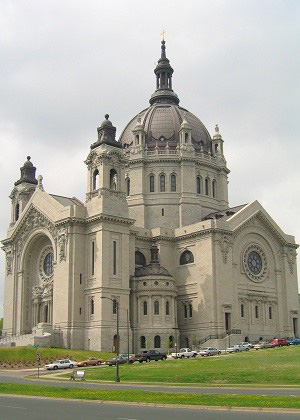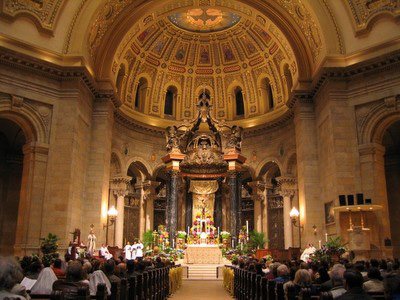 |
||||||||||
 |
||||||||||
|
1422: The Cathedral of St Paul, St Paul, Minnesota,
USA Mystery Worshipper: Forradal. The church: The Cathedral of St Paul, St Paul, Minnesota, USA. Denomination: Roman Catholic. The building: The present building, the fourth, dates from 1905 and is the work of the French architect Emmanuel Louis Masqueray, chief designer of the 1904 World's Fair in St Louis. The cathedral is a beautiful example of classical Renaissance French architecture and is lovingly described in great detail on their website. There is no hyperbole in saying this building is BIG – it must surely be one of the largest cathedrals in North America. Depending on the seating arrangement, it can hold between 3000-4000 worshipers. Even with modern day electric lighting, the interior is dim. With gas lighting, masses under the old Latin rite must have presented an almost medieval aura – and a visually stunning, sensory experience. Added to the church in 1987 were five large bronze bells cast in France, replacing the original single bell which, according to a former rector, was "not loud enough to scare a pigeon." The church: In 1840 a missionary priest, Father Lucien Galtier, was sent to minister to the rough-and-tumble French Canadians living in a settlement known as Pig's Eye, in a place called Minnesota – not yet one of the United States. Father Galtier built a wooden chapel with unshaven sides and a bark-covered roof in an area thick with trees and bramble. He placed the community and the chapel under the patronage of St Paul as patron saint of gentiles, praying that the residents would come to call the place St Paul instead of Pig's Eye – which they did! The settlement quickly outgrew its humble chapel, and a larger one was built just three years later. In 1851 the Diocese of St Paul was formed by Pope Piux IX and the new chapel – already bulging at the seams with its ever-expanding congregation – suddenly became a cathedral. On May 11, 1858, Minnesota became the 32nd state to be admitted into the United States, and mass was celebrated at a new stone cathedral a month later. But St Paul continued to prosper and grow, and by the turn of the century what had now become the Archdiocese of St Paul once again needed a new, more spacious cathedral building – a need fulfilled at last with the consecration of the present building in 1958 at a five-hour ceremony! Today, the cathedral serves a multi-ethnic community though I could find no mention in the bulletin of special masses for non-English communicants. Based on the activities listed in the bulletin, this seems primarily to be an adult worshiping community. The cathedral sponsors a variety of ministries all enumerated in detail on their website. The neighborhood: A very interesting neighborhood indeed! This part of the city is close to the Mississippi River, which cuts diagonally through the area, making for a maze-like collection of side streets. To the west of the cathedral are the enormous century-old grand homes of St Paul of yesteryear. To the north are refurbished brownstone apartment buildings, now converted into condos. On the east side, about six blocks away, are the Minnesota state capitol and the state historical society, two imposing and well-designed structures. In between the cathedral and these two buildings one finds something akin to an architectural desert, with a collection of nondescript state governmental buildings with little, erm... NO architectural style. Two freeways quite appropriately bisect this architectural wasteland! The cast: The participants in the mass were announced beforehand. However, due to a mostly inaudible public address system, their names were not easily understood. The bulletin listed the names of all the cathedral clergy: the archbishop, cathedral staff, etc., with no indication of which of them were actually participating in the mass. The date & time: Fourth Sunday in Lent, March 18, 2007, 12.00pm. What was the name of the service? Mass. How full was the building? The building was approximately 30 percent full as mass began. Worshipers continued to drift in for an additional 30 minutes! By the end of the sermon the cathedral was about half occupied. One wonders if this also happens at the nearby arena during professional sports events. The front pews tended to be occupied by older folks, while the young crowd sat toward the rear. I likewise took a rear seat although agewise I belonged closer up front. Did anyone welcome you personally? I arrived early and was not welcomed by anyone, nor did I notice anyone welcoming the later arrivals. The worship material was obtained from a table in the narthex. I was early enough that I had plenty of time before mass for a self guided tour of the cathedral. The size of the building is awesome, but also creates a sense of anonymity amongst the worshipers. Was your pew comfortable? I am not an overly lanky guy, but I found the pew to be short for both sitting and kneeling. I had quite a bit of difficulty maintaining my balance during the kneeling portions of the mass; even half sitting-half kneeling didn't work well. Admittedly, when the building was designed, the average height of a man was well under six feet. How would you describe the pre-service atmosphere? The gospel for the day was the parable of the prodigal son, and the organ prelude was The Prodigal Son, composed by James Biery, director of music at the cathedral. Unfortunately the cathedral's acoustics enabled three fussing babies to sound like a special infant chorus that drowned out the Æolian-Skinner gallery organ. What were the exact opening words of the service? "Rejoice, O Jerusalem, and come together all you that love her," from the introit for the day (formerly known as Laetare Sunday, from the Latin word for rejoice). This was followed by the processional hymn, "The King of love my Shepherd is." What books did the congregation use during the service? A very well designed service bulletin, with notations for the hymn numbers, the musical line for the chanted responses, and the rubrics of the mass. All church bulletins should follow this example! There was also a hymnal, but sadly I neglected to jot down the title. What musical instruments were played? The cathedral holds two organs: one in the sanctuary and another in the gallery. The two manual sanctuary organ, a 1927 Ernest M. Skinner instrument, is voiced closer to the romantic style, most likely designed to accompany the choirs during the Latin rite mass. Listening to the Latin rite Gregorian chant reverberating across the expanse of this building was, no doubt, a wonderfully sublime experience. The three manual 1963 Æolian-Skinner gallery organ, voiced closer to the classic style, was used at this mass. It is somewhat small for a building this size, but is voiced well and was played expertly. Congregational singing simply wasn't envisioned when this cathedral was designed, so the liturgy and hymns were sung s-l-o-w-l-y and reverentially. This pace is simply a fact of life in a large reverberant building. Did anything distract you? The spoken word was often lost in the reverberation. Add a few crying babies – well, you get the point! And 30 minutes late for mass? Was the worship stiff-upper-lip, happy clappy, or what? The mass was formal and reverential without being austere and cold. There was incense, but not many bells and whistles, as befits Lent. The clergy did not rush through the liturgy; the mass was devout and very meditative. But only about one-quarter of the congregation participated in the singing. Interestingly, no bulletin or spoken references suggested Catholics only during communion. (But not being Catholic, I did not partake.)  Exactly how long was the sermon? 13 minutes. On a scale of 1-10, how good was the preacher? 6 – I give the priest a 6 for his delivery and sermon material. Due to the acoustics, the spoken word receives a 2. I hope the staff finds a generous benefactor (perhaps a new patron saint!) who will help correct this problem. The priest also used a number of ad libs that didn't seem to be connected to his message, causing our attention to be momentarily diverted. In a nutshell, what was the sermon about? He drew parallels between the story of the prodigal son and our life as 21st century Christians. In baptism we are joined to Christ, but our sinful nature causes us to rupture and break this holy relationship. In today's world we sometimes think we are immune from sin – our world is so filled with stuff and fluff. We often approach the Christian faith in the same way we review a cafeteria menu – some of this and some of that. However, in confession we are reoriented and refocused in God's grace and forgiveness. Which part of the service was like being in heaven? The Kyrie was sung without organ – very moving in this building's space. The closing hymn was one of Bach's chorales, which again in this space sounded wonderful! And which part was like being in... er... the other place? Worshipers 30 minutes late! Was I at church or the train station? What happened when you hung around after the service looking lost? It wasn't difficult to play the stranger here – just about everyone played that role. It is assumed the cathedral has a core group of active parishioners – with the rest falling into the more traditional pray and pay category. In good Christian fashion, just about everyone dashed for the doors before the last chord of the recessional hymn was struck. This was unfortunate because the organist played a wonderfully meditative Max Reger piece for the postlude (Herzlich tut mich verlangen). How would you describe the after-service coffee? None provided for this service and none indicated in the bulletin. How would you feel about making this church your regular (where 10 = ecstatic, 0 = terminal)? 9 for the building, but 4 for the acoustics. Worship in a building of this size can be very inspiring and awesome, but attempting to understand the spoken word must be an advanced art form. I think I would find this frustrating on an every Sunday basis. Did the service make you feel glad to be a Christian? Listening to Bach always makes me happy to be a Christian! Even with the distractions, the worship was devout and meaningful. What one thing will you remember about all this in seven days' time? The a capella Kyrie in the wonderful space of this cathedral. |
|
|
||||||||||||||||||||||||||||||||||||
| More Mystery Worshipper reports | |||||||||||||||||||||||||||||||||||||||
 |
|||||||||||||||||||||||||||||||||||||||






